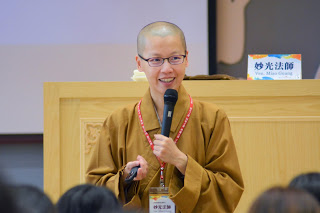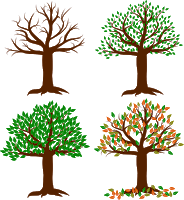
Speaker: Venerable Miao Guang
Fo Guang Shan Institute of Humanistic Buddhism
I. Introduction
Auspicious blessings to you all.
May everyone be well and healthy.
Thank you for including the FGS English Dharma Services Channel in your weekly cultivation. We are happy to have proceeded into Season 2: Benefiting Self and Other.
This week, as requested by some of our audience, I would like to offer an introduction to the Heart Sutra.
We know that, including our current chanting procedure, in almost every short Buddhist service at FGS, the Heart Sutra is always being chanted.
There are three reasons to why we chant a sutra in a Buddhist chanting service:
- For heart-to-heart connections with the buddhas and bodhisattvas.
- For merits and blessings that arise from the act of reciting the Buddha’s sacred teachings.
- Most importantly, to attain the insight and wisdom from the teachings delivered by the buddhas and bodhisattvas which are being chanted.
Many of us have probably done this hundreds of times.
However, have you ever wondered why the Heart Sutra is so common?
What is the text teaching us?
Is this teaching easy to understand to you?
How much of it are you yet to grasp?
II. The Sutra Title

Let us begin with the title of the sutra: Prajna-paramita-hrdaya-sutra Prajna-paramita means the perfections of wisdom.
Hrdaya represents the heart or core.
Sutra means the discourse that was delivered by the Buddha, or in the presence of the Buddha.
We can look at the Sanskrit words backwards, and see that Prajna-paramita-hrdaya-sutra means a discourse on the heart of the perfection of wisdom.
Prajna-paramita also represents The Other Shore. Therefore, by learning the heart of this wonderful insight or teaching, we are able to perfect our understanding [of the Dharma], and eventually reach the other shore.
III. In the eyes of an awakened one — Three levels of Emptiness

In the Heart Sutra, Avalokitesvara Bodhisattva is being asked a question by Sariputra under the inspiration of the Buddha, who has entered deep samadhi. The question asks, “How does one practice and train, in order to attain the perfection of wisdom. Thus we are lead into the sutra with this Q&A, where we see this awakened sentient being, Avalokitesvara Bodhisattva, who seems to sit in a very relaxed and free posture, and entered a deep contemplation on his journey of awakening. Thus the Sutra opens with:
Avalokitesvara Bodhisattva,
while contemplating profoundly the Prajna Paramita,
Realized that the Five Skandhas are empty,
and thus he was able to overcome all suffering.
We now join the awakened sentient being on this journey of enlightenment, where we are taught the three levels of emptiness (sunyata) in order for us to better understand the self, and world, as well as the relationship between self and other. On level one, Avalokitesvara Bodhisattva talks about the emptiness of the self by telling us that he realized that the Five Skandhas are empty, and this is how he was able to overcome all ills and suffering.
What are the Five Skandhas?
Also known as the Five Heaps or the Five Aggregates, they consist of
- Form, which is the colors or physical shapes which our sensory organs can detect;
- Feelings or sensations which arise as a result of our sensory organs coming in contact with the physical forms;
- Perception, which is when we begin to label these experiences as good or bad, or these images such as good or bad;
- Mental forces, or volition, which become the decisions or the intentions which result from the perceptions which will affect how we react to these experiences; and
- Consciousness, which is basically a storage of the experiences and memories of the previous four, which on the next experience of a similar form or sensation, when these memories come back, will affect the way of responding or reacting to that.
In other words, we can refer to the Five Skandhas as the Five Aspects of the Human Experience, where we rely largely on our sensory organs and the brain to react or to interact with the physical world.

For example, what do you see on the screen? If you tell me that it is a scoop of ice cream, I would have to say, “Why?”
Chances are it would have been on some occasion, when you first saw this round, white, glistening, scoop; and when you put a part of it onto your tongue or your taste buds tell you that this is a very icy, sweet, cool, and beautiful sensation. So you perceive this as something delicious, a wonderful dessert. Then the next time or following that experience, whether you like it or not, your mental forces of evolution will make a decision as to where you want more or you’re going to reject this experience that you do not like. Then this process is stored in your consciousness and that is why at this moment when you see this picture, you would tell me that it’s ice-cream.
But what if I told you that this is not ice-cream, it’s actually a scoop of butter. Suddenly your memory of that cold, icy, sweet, glistening sensation at the tip of your tongue turns into something greasy and sickening. So the next time when you see something similar, you’re not going to jump to the conclusion of picking up the spoon to actually take a large group to put into your mouth. Next time you’re going to examine a little bit more. Therefore the Five Skandhas according to Avalokitesvara Bodhisattva are empty.
By empty, it actually means that these do not have an everlasting, unchanging, eternal self. They’re all momentary coming-togethers of conditions which eventually will disperse; and anytime these conditions disperse, your experience of that form, or your labeled feeling or sensations will begin to change.
To see that the Five Skandhas are empty, it means that we are able to take a peek through reality in detail, and not be led by the nose based on these feelings or sensations. According to Avalokitesvara Bodhisattva, by overcoming this or by seeing that these are empty, then there’s a chance for us to overcome suffering.
What does suffering (dukkha) mean?

The meaning of dukkha is threefold. First of all, we usually understand dukkha as “suffering.” However it perhaps should not be translated as suffering, but merely as dissatisfaction. If we ask ourselves, what is the suffering of the body? We must realize that while the body is conducive to suffering, but in and of itself, the body is not itself suffering. That is, when you ask which of the body and suffering comes first? When Avalokitesvara became free from suffering, what did he get rid of? This is the moment when this Bodhisattva teaches us that by seeing that the Five Skandhas are empty, one does not eliminate anything. What we do is actually that we abandon the desire for that thing. What we must realize is that when desire is not fulfilled, or when what you end up getting is not what you want you feel dukkha. So, why is it suffering or dissatisfaction? It is so because the ‘I’ do not like it.

The second definition of dukkha is “change.” Since we have a notion of the self, we tend to hold onto the idea of a permanent self. We usually do not wish to recognize that we’re different, that we’re changing all the time. The wish for the body to be permanent when its nature is change brings about dissatisfaction or happiness.
The third definition of dukkha is when we refuse to accept the fact that everything is “conditioned.” When the conditions come together, that is when we experience the phenomena. However, we must realize that eventually, the conditions will also disperse. Once these conditions disperse, what we are experiencing will also disappear.

Therefore, as the Bodhisattva sees the emptiness in the dukkha that arises out of the notion of ‘I’ that refuses change or that ‘I’ that wants to be this overall independent phenomenon, then there is a chance for us to see the Level One Emptiness–Emptiness of the Self.
The Heart Sutra goes on to say,
Sariputra, form is not different from emptiness.
Emptiness is not different from form
Form is in fact emptiness, and emptiness is in fact form.
This also applies to feeling, perception, volition, and consciousness.
In this line, we see that the translation of sunya is translated as “emptiness,” or sometimes “void,” or “devoid.” This means when we say that form is not different from emptiness, we are not saying that there is nothing when we see form. That would not be right. It’s about the experience of the form that is empty of the self. To say form is emptiness, and emptiness is form, it means that form and emptiness are not empty of each other; they are only each other. You could now try to close your eyes, stay that way for a few seconds, and then open your eyes again. When you open your eyes, you see emptiness, and when you see form, you are looking at emptiness. In other words, when we say that all of the Five Skandhas–form, feeling, perception, volition, and consciousness are emptiness, and emptiness are these, the Heart Sutra is teaching us that sensorium is all human experience. Anything else would just be mere talk.
The Heart sutra goes on to say,
Sariputra, emptiness is the nature of all dharmas.
It can neither be created nor annihilated,
polluted nor cleansed, increased nor decreased.
This is telling us that by emptiness, we are referring to a special characteristic or quality. Being a principle itself, no physical phenomena can make any changes to it.
Therefore, in emptiness there is no form, feeling,
perception, volition, or consciousness.
No eyes, ears, nose, tongue, body, or mind, No form, sound, smell, taste, touch, or conception.
No object of sight, and no consciousness.
This displays the sensory process where we see that the experiential aspect of the sensory process include seeing, hearing, smelling, tasting, tactile, sensation, and mental state. While the Non-experiential is that which is beyond our physical ability to see, hear, smell, taste, tactile, conception, and mental states. In other words, what we are really experiencing through the sensorium is carrying the nature of emptiness, and by realizing this, we come closer to emptying ourselves of dukkha.

A few years ago, I visited the Fo Guang Shan Culture and Education Center in Beijing. It was a long rectangular building. When I checked-in, I came across a little girl who ran across the corridor, screaming, laughing, having fun with her family. After I dropped my luggage, I went on to have class. By the time I returned to my room after 11p.m. They had turned down the lights in the corridor. As I approached my room, I couldn’t help but seeing that little girl, standing alone at the end of the corridor. I wondered why at this time she would be out there alone. Was she waiting for somebody? Or was she scared to move around until her family came to fetch her? She was standing there quietly, and her skirt waving as the air conditioning continued to operate. I looked at her and then even before I decided to approach her, this eery feeling or sensation came across my mind. It was a question. Is that really a little girl? If that’s not a little girl, do I want to approach her? At the end of the day, my decision was to turn away and just walk into my room. But I spent the whole night wondering whether that was really the little girl I had come across early in the afternoon? The question just floated over my mind for the entire night, and somehow the eerie feeling carried on. Until the next morning, when I stepped out of my room when there was sunlight, I once again looked down the corridor, I couldn’t help but laugh at myself. It was just a tall green plant that was placed next to the window, and the skirt that was waving in the wind was actually a large leaf that moved along with the air conditioning. At that moment the eerie feeling of whether that was or was not a little girl just disappeared. At that moment I felt like I had emptied myself of the fear which I created out of nothing but my own preconceptions.
Therefore, when Guanyin/Avalokitesvara Bodhisattva says we must first see that the Five Skandhas are empty, perhaps this is for us to realize that we should not grasp onto what our perceptions, volition, and mental formations, as well as consciousness, are telling us to do.
So far emptiness in the Heart Sutra shows us on level one, in order to overcome suffering or dukkha, we must first understand the emptiness of the self.
Now we move on to the next passage in the heart Sutra where it says,
No ignorance, nor its extinction;
No aging and no death, nor their cessation.
No suffering, causes, cessation, nor the path.
In this section, we see that Sariputra is being taught the reality of practice, where we see that by using the sensorium, it tells us that what we experience is not the thing itself. This is a moment of mere observation. We have to ask who is looking at whom? This is where Sariputra is taught the importance of the prajna-paramita, where he now embarks on the journey of the Bodhisattva Path by transformation of the human consciousness so that the distinction between self and other is transcended, and now absolute reality is experienced. Just as said before on the first level, we see emptiness of the self, and then this is the moment where we learn that in somehow a similar way, we’re learning the emptiness of all phenomena in ourselves and outside ourselves.

As we look at the meaning of suffering which is three-fold just as said previously, we understand that suffering not only comes from the within, but whatever happens on the outside could continue to change our perspective of suffering, and somehow cause us to mistake the fact that this dukkha is coming from the outside.
Once there was a lady who was about to embark on a journey. It was a very full and busy day, and when she finally found herself a seat, it was shared with another young man. As she was waiting for the train to come she decided to enjoy herself by reading a newspaper and treating herself to a pack of chocolate chip cookies. However, as she took out one chocolate-chip cookie, something strange happened.

The man sitting next to her without saying a word just reached out for that pack of chocolate chip cookie wish she had bought and then helped himself with a piece. This made her very uneasy and unhappy. She was no longer able to focus on the newspaper she was reading; and all along, even though she was chewing her favorite chocolate chip cookie, all she could think about was why is this man acting so rude by stealing my chocolate chip cookie. In order to maintain her composure, she stayed calm and helped herself to a second piece of chocolate chip cookie. Then the funny thing happened. The man too, without saying a word again, also helped himself with a second chocolate chip cookie. She held herself together and tried to be patient.

Finally, when there was only one piece of chocolate chip cookie left in the bag, she looked at the man and smiled, thinking, “I’m just going to wait to see if you would have at least the courtesy of letting me have my own last piece of chocolate chip cookie since I have shared most of my packet with you.” Then the man also turned to her, smiled, and reached out for that final piece of chocolate chip cookie, broke it in half, and shared one half with her.

The lady’s patience was about to run out. As she was about to explode, luckily the train came. So she quickly gathered her bag, jumped onto the train, thinking that she would now finally be away from this rude, selfish man. Upon last glance, this man still showed her a smile. Perhaps he wanted to thank her for the free cookies.

Now that she was finally sitting on the train, she told herself, “Look I’m going on a holiday. I should not let this ruin my mood. Let me go back to the trip, enjoy my newspaper, and then get on with the holiday. Something fun funny happened. As she turned back to her bag to get her newspaper, what she saw in her bag, was a whole new unopened bag of chocolate chip cookies. All along, she had been eating out of the young man’s bag of chocolate chip cookies, who was very generous and kind to share with her even to the last piece, with a smile.
So as we say that dukkha arises because of a disharmony between the self and the world, it is not to say that this world is enforcing disharmony on to us, but merely due to our preconceptions and our misunderstanding that what we are experiencing is the Truth that causes the dukkha. Therefore, coming to this part of the Heart Sutra, Avalokitesvara Bodhisattva teaches Sariputra as well as all of us an understanding of emptiness which applies not only in the coming together of the notion of self, but also in the coming together of all the phenomena that we live in, such as the cycle of birth and death as well as dukkha and its causes, its cessation, or the path.
To understand that after all, there’s nothing to cling onto, that there’s no need to treat them as the absolute reality, then we have an opportunity not only to overcome caused by the self, but also through understanding the emptiness of all phenomena, we will also be free from the bondages of the physical world that continues to cause us a dream and to have the delusive thoughts.
No wisdom nor attainment.
As there is nothing to attain,
Now the last line in this section tells us that beyond the transcendence of the cycle of rebirth as well as dukkha and its end, eventually, we come onto the Bodhisattva Path whereby understanding emptiness, for a bodhisattva, not only are no longer a notion of the self or reality, there’s even no notion of wisdom nor the attainment of that wisdom. In other words, we are now looking at Level 3 Emptiness which is emptiness all even all concept. Upon this level, the bodhisattva is teaching us how to transcend the dukkha caused by knowledge or concepts. This is the moment when bodhisattvas overcome all senses of dualism. There are no longer the concepts of good or bad, you or me, whereby the bodhisattva sees the self and other as one. The bodhisattva sees dukkha and happiness as one. There are no longer differentiations.

This is similar to the eyes of a mother when her child is sick. You will see very often when this case arises, it would come to the extent that even the mother herself gets sick just because her child is sick. So the bodhisattva heart is like a mother’s heart where she sees herself and her child as one. She feels everything that her child is feeling, especially the dukkha. As we say that at this point there is no wisdom nor attainment, what the bodhisattva has realized is that whatever the bodhisattva attains, he should also help sentient beings attain the same thing. Whatever the sentient beings are feeling, the bodhisattvas would also feel. This is in particular, relevant to the case of suffering. You will see Avalokitesvara manifesting in all forms and using all kinds of ways to cater to the needs of the myriad sentient beings in order to help them overcome suffering. So, the sutra goes on,
As there is nothing to attain,
a bodhisattva who relies on the Prajna Paramita
has neither worry nor obstruction.
As there is nothing to attain a bodhisattva who relies on the Prajna-Paramita has neither worry nor obstruction. Since you have nothing to overcome, there’s nothing that you would see as a challenge. Since you have nothing to attain, there’s nothing you need to see or try to understand because everything is already a part of you.
Without worry and obstruction, there is no fear,
Away from confusion, daydreaming, and thus reaches Nirvana.
So we see that the bodhisattva attains the Perfection of wisdom by overcoming all of these understandings or the notions of the self, notion of the phenomena, or even notions of notions. So the bodhisattva is extremely clear and aware of what is happening in reality without being affected. That’s why the bodhisattva has no confusion and finally reaching Nirvana, the absolute moment of tranquility and freedom from all forms of discrimination. This is where the Heart Sutra moves on to say,
Thus, one should know that Prajna Paramita is the great mantra,
The mantra of illumination and the supreme of all mantras.
It is an unequaled mantra and able to emancipate all suffering.
This is true and not false.
People would often ask whether the Heart Sutra is a sutra or a mantra? The answer could be both. What we see from this line onwards, it covers the mantra aspect of the Heart Sutra. But anything before follows the style of prose, a more common literary style that we see amongst all Buddhist sutras that explains the journey of awakening according to Avalokitesvara Bodhisattva.
Another way to look at the Heart Sutra is from this point onwards, you may not remember anything above, or even if you have really internalized all that has been taught to above, your understanding can be represented by this one final line, where it says
Thus in proclaiming the Prajna Paramita Mantra, one says,
Gate Gate Paragate Parasamgate Bodhi Svaha.
This means gone, gone, gone beyond, gone together beyond,Awakening, all hail. The attainment of the Perfection of Wisdom represents your ability to reach the far shore of enlightenment or Nirvanaon from this shore of birth and death, where the river are our experiences of reality. We take one step at a time to overcome one delusion after the other through clear insight.
IV. Conclusion
To sum up. The Heart Sutra in a nutshell, the teachings of Avalokiteshvara helps us understand emptiness on three levels:
- Emptiness of the self: where we will no longer hold onto the notion of self as something true or eternal. It’s constantly changing, it’s not real, and it should not be something that controls us.
- Emptiness of all phenomena: we understand the emptiness of all phenomena. Even the reality of death, the reality of dukkha can be something that, once we attain the insight of Prajna-Paramita, can eventually overcome.
- Emptiness of concepts: Ultimately, what Avalokitesvara wants to tell us this the emptiness of concept whereby saying that there’s no wisdom nor attainment, Avalokitesvara Bodhisattva reminds us that the raft which carries us across the ocean or the river of birth and death across to the far shore of nirvana or enlightenment eventually will have to be abandoned, because they are after all only conventional. The way bodhisattvas overcome the emptiness of the concepts is by blending both ends of dualism. To see self as other, to see good as bad, or to see all of these together as parts of the self. Just like the mother, all the good and bad experienced by her baby or her child will be parts of her. In order to really reach that state, we’ll have to rely on our ability to slowly let go of our ego and attachment to what we think is reality.
Certainly, there is still a lot for us to discuss. Hopefully, today I have been able to deliver a basic walkthrough of the Heart Sutra so that from now onwards, whenever we chant the lines of this very short and concise text, we’re able to dwell deeper into the very profound wisdom which both the Buddha, Avalokitesvara, and Sariputra can help us understand.
Thank you very much for listening.
May this world be free from turmoil of the Outbreak.
May each and every one of us be safe and well.
I hope to see you next time. Thank you very much
